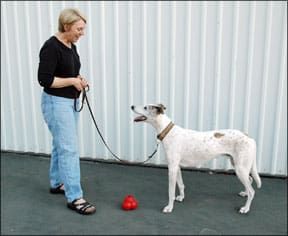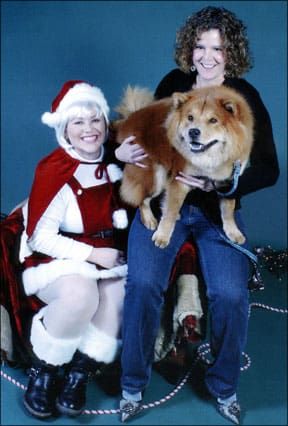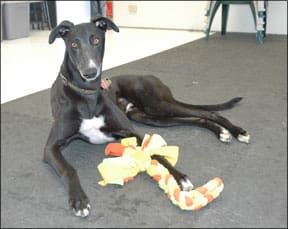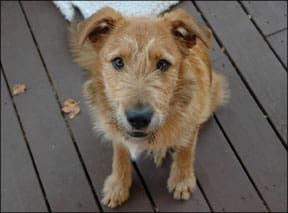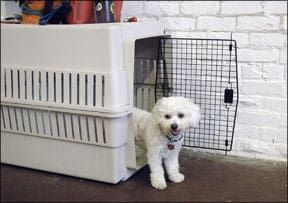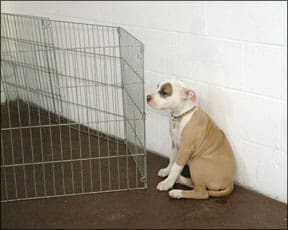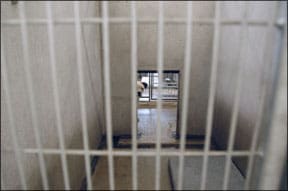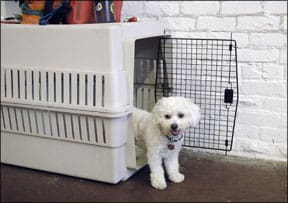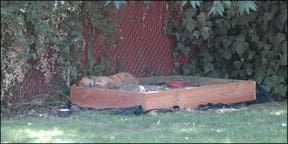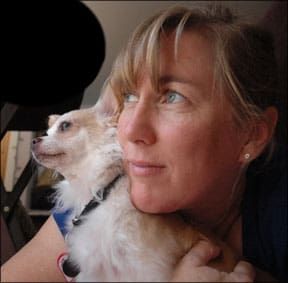Download the Full August 2008 Issue PDF
Teaching Your Dog to “Leave It” On Cue
[Updated August 9, 2017]
There’s nothing like a steaming-fresh pile of moist, warm horse manure to convince a dog owner of the vast difference between canine and human sensibilities – or of the great value of a reliable “Leave it!” cue. Since my husband and I share our lives with four dogs and 15-some equines, you can imagine that “Leave it!” is an important entry in our dogs’ lexicon.
You don’t have to live on a horse farm to appreciate the value of “Leave it.” A kitty-litter box can be just as tempting as a stall full of horse “apples.” The “Leave it” behavior, defined as “look away from whatever you’re looking at or coveting at this moment,” is useful in an almost infinite number of possible canine encounters:
• You drop your high-blood pressure pill on the floor. “Leave it! Good dog!”
• Your two-year-old child toddles past with a melting ice cream cone in his hand at canine nose level. “Leave it! Good dog!”
• You see your Irish Wolfhound studying the holiday turkey on the kitchen counter at canine eye-level. “Leave it! Good dog!”
• Your adolescent Labrador Retriever is preparing to offer an enthusiastic greeting to your elderly Aunt Maude who is approaching up the front walkway with the assistance of her wheeled walker. “Leave it! Good dog!”
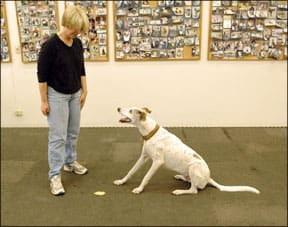
• Your cat-chasing Jack Russell Terrier spots a black-and-white “kitty” (think skunk) trundling across your backyard at dawn when you let him out to potty as you’re rushing to get to a critically important meeting on time. “Leave it! Very good dog!” You just saved your job!
• You’re walking your dog in the park and spot a half-dozen suspicious-looking balls of raw hamburger at the same instant your dog does. “Leave it! Very very good dog!” You just saved your dog’s life; the hamburger was laced with strychnine.
I could go on, but I’m sure you get the picture. A cue that can divert your dog’s intention to chase, greet, or eat someone or something is a life-saving, sanity-saving, versatile, mandatory part of every well-mannered canine companion’s behavior repertoire. So how do you go about helping your dog acquire this vital skill? It’s easier than you might think.
Training a Dog to Leave It: Step 1
The foundation “Leave it” behavior is so important – and so simple – that we teach it in our Puppy and Adult Basic Good Manners classes. We introduce it in Week 4, and it’s an exceedingly rare dog who doesn’t perform it to near-perfect on graduation night just three weeks later. Here’s how it works:
Show your dog a high-value “forbidden object” – something you’re going to tell him he can’t have. I like to use freeze-dried liver cubes for this – they are high value and durable. (You’ll see why durability is important in just a minute). Let him sniff it, lick it, even nibble at it, but don’t let him have it.
Now say “Leave it!” as you hold up the cube, then immediately place it on the floor under your foot, to protect it. Note: Be sure to wear sturdy shoes. Do not do this exercise barefooted, with open sandals, or in your Sunday-best patent leathers.
Let your dog sniff, lick, and nibble at the treat under your foot. He might even chew at it. If his tongue can reach the cube under your shoe, tip your toe forward so he can’t actually lick it. You don’t want him getting reinforced even by a tiny taste, if you can help it.
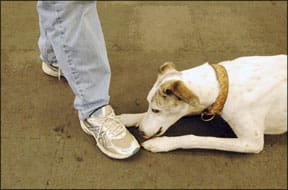
Now just wait. Don’t repeat the cue; he will eventually give up. I promise. The split second he stops sniffing, licking, etc. or looks away, even if it is by accident, “mark” the moment by clicking your clicker or saying “Yes!” and give him a tasty treat. He’ll probably return his attention to the forbidden object under your foot after the click and treat, so just wait some more. Don’t repeat the cue. (See why below.) When he looks away again, click and treat again.
If you can, give him another click and treat before his nose returns to your foot. You want to reinforce the behavior of “look away, look away, look away, keep looking away” as much as possible; you’re not looking to create a behavior chain of “look at foot, look away, look at foot, look away (although you will get some of this, at least at first). After several repetitions, pick the cube up from under your foot, show it to him again, now repeat the “Leave it” cue, and place it under your foot again.
When he looks away from the inaccessible cube easily, you’re ready for the next step. Move your foot away slightly to uncover the treat and give repeated clicks and treats as long as his nose doesn’t return to the treat. This communicates to him that he gets rewarded for staying away from the cube, even when it’s visible and seemingly accessible. Keep your foot close! You may want to just keep your heel in place and pivot your toe away from the treat at first. If your dog dives for the food, just re-cover it with your toe to prevent him from getting it. Click (and treat) again when he looks away.
If your dog appears to have completely forgotten that the forbidden object is on the ground, every once in a while you can tap your toe next to it to draw his attention back, but be ready to cover it up quickly! Remember, he doesn’t have to look back at the cube and then look away – you want continuous “look away” behavior.
Eventually you will see your dog’s “Aha!” moment – that golden moment in training when you get to see your dog really understand what you’re asking him to do. With “Leave it” that golden moment happens when he looks at the exposed cube, considers it for a moment, and then looks up at you in anticipation of his click and treat. Celebrate!
Don’t Repeat the Cue!
It is almost irresistibly compelling to repeat the cue when your dog makes a move for that liver cube. It’s hard to resist the normal human automatic reaction to tell the dog what to do even when you know your dog doesn’t yet understand what the words mean. We are a verbal species; our dogs are not.
When you cover the cube with your foot rather than repeating the cue, you’re speaking your dog’s language – using body language to communicate to your dog that the cube belongs to you, and he can’t have it. In fact, the reason this exercise works so well is that when you cover the forbidden object with your foot, you’re resource-guarding. Now that’s a behavior your dog understands – dogs do it all the time!
You also want your dog to understand that once you’ve said “Leave it” you mean “leave it forever.” You don’t want to have to keep reminding him.
Imagine you’re having a cocktail party. You carry your tray of hors d’oeurves into the living room, and as you bend down to place them on the coffee table, you tell your dog to “Leave it!” You don’t want to spend the rest of the evening guarding the goodies; you want your dog to leave them alone for the duration of the party.
ln order to accomplish that desirable end, don’t repeat the cue. Use your foot to protect that liver cube, or body block to send the resource-guarding message. Show your dog with your body language that the cube belongs to you; resist the temptation to tell him. Then when you’re done practicing, pick the cube up and put it away for the next training session, or feed it to him in a different location. Don’t make the mistake of telling him he can have it. Remember, “Leave it” – one cue – means “Ieave it forever.”
Training a Dog to Leave It: Step 2
When you can routinely place the forbidden object on the floor without your dog trying to get it, without having to cover it with your foot, you’re ready for step two – the “Leave it/Drop.” This step starts to approximate some real-life applications of “Leave it.” For example, the situation described in example #1 above, where you drop your medication – or perhaps a piece of chocolate candy (chocolate can be deadly to dogs).
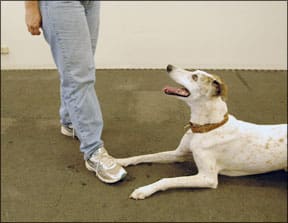
Warm up your dog’s “Leave it” as described above. When he’s easily leaving the cube, stand facing him with the cube in your hand, say “Leave it!” and drop it slightly behind you and slightly off to one side.
Whoops, be careful! A poorly placed drop and the cube can take a bad bounce, landing directly under your dog’s eager jaws. Err on the side of caution, especially at first. Behind, and slightly off to one side. If your dog moves to grab the cube, body block by stepping in front of the dropped object or by covering it with your foot. Don’t yell “Leave it!” or make any other aversive noise. Just protect the object so your dog can’t get it, wait for him to look away from it, and then click and treat.
Now pick the cube up and try again, using your calm “Leave it!” cue with each drop repetition, until you can give the cue and drop the cube without having to make any protective maneuvers. Practice this until your dog will do “Leave it/Drop” without any prior warm-ups. Remember to click and treat each time your dog leaves the forbidden object alone, and to click and treat several times to extend the duration of his leave-it behavior. Now you’re ready for step three.
Training a Dog to Leave It: Step 3
How often do you have the chance to say “Leave it” before you accidentally drop your box of chocolates on the floor? Not too often, I’ll wager. To more closely approximate real life, you need to make one more adjustment to the “Leave it” exercise: the “Drop/Leave it.”
Warm up with several of your step two “Leave it/drop” repetitions. Now switch the order: drop the cube and say “Leave it” immediately after it hits the floor. Again, start with strategically placed drops so you can body block if necessary. In fairly short order you should be able to drop the cube in random locations, followed by a well-timed “Leave it” cue. Practice until your dog will leave it for you after the drop, even on “cold” trials.
Now you can generalize “Leave it” to more real-life situations.
The Generalized “Leave It”
It’s best to start generalization work with your dog on a leash. You’re going to be doing set-ups with forbidden objects that you won’t be able to cover with your foot, so you’ll need your leash to restrain your dog so he can’t help himself to the objects.
On a surface such as an asphalt or concrete driveway, or hardwood or tile floor, set up a “temptation alley” – a line of moderate- to high-value objects. Place the items in a line, five to 10 feet apart. Then approach the first item with your dog on his leash, far enough from the line that your dog can’t reach the objects.
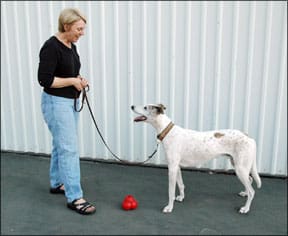
When your dog notices the first item in the line, say “Leave it!” in a cheerful tone of voice, and stop moving. Restrain your dog so he can’t grab the object. You should be far enough from the line that you don’t have to jerk him back to keep him from getting it. Like you did with the liver cube under your foot, just wait for him to give up and look away from the object. The instant he looks away, click and treat, then move forward. If he pulls toward the object when you move forward, stop, give another “Leave it!” cue, and wait until you can click him again for looking away. If he doesn’t look at the object as you move forward, continue to click and treat him for good leash walking, until he notices the next object.
Repeat the exercise with that object. Continue on until you can pass the whole line of tempting items, and he will respond to your “Leave it” cue without ever putting any tension on the leash.
Your goal is to get your dog to reliably respond to the “Leave it!” cue on cold trials (first time you present a new forbidden object) without putting any tension on the leash. When he’ll do that, he’s ready to try it off leash!
Now look for random real-life opportunities to try out his new skill, on-leash or off. Remember to keep your cue cheerful; you’re just giving your dog information (“Look away from that object for an opportunity to be reinforced”). You’re not trying to intimidate him away from the object. If you see any lapses in his real-life random trial “Leave it” responses, schedule more on-leash set-up training sessions. If his training carries over successfully to real life, the two of you have earned another celebration!
With 15 horses on our farm, each producing approximately 35 pounds of poop per day; random groundhogs, deer, toads, and baby birds outdoors; three chaseable indoor-only cats, and a variety of dropped items and other “forbidden object” occasions around the house, “Leave it” is a common household cue for our dogs.
One of my most rewarding stories comes from a client of mine in Tennessee, however, who tells of his dog finding poison meatballs in his own backyard, immediately returning to his owner’s side when cued to “Leave it.” His dog’s prompt response even when tempted by the tasty but deadly morsels likely saved his life.
Pat Miller, CBCC-KA, CPDT-KA, is Whole Dog Journal’s Training Editor. Miller lives in Hagerstown, Maryland, site of her Peaceable Paws training center. Pat is also author of The Power of Positive Dog Training; Positive Perspectives: Love Your Dog, Train Your Dog; Positive Perspectives II: Know Your Dog, Train Your Dog, and the brand-new Play with Your Dog.
Always More Than One Way
First, I want to say I love getting WDJ every month and the information has been very timely for me. But as much as I like Pat Miller’s advice and philosophy for dog training and I refer to her always, I need to respond to the article about teaching dogs to walk nicely on a leash. I am a Tellington TTouch Practitioner and dog trainer (for 30 years) and the TTouch method of teaching dogs to walk in balance is another very positive and gentle way of working with them. Please check it out with a TTouch practitioner near you!
Melissa Hardy
via e-mail
I loved your Editor’s Note (Spending Time Together) in the June issue; it was as if I wrote it. I grew up on a farm in South Texas but everything else was ditto to your article.
One of my greatest stories was of our Border Collie, Boots, who got hit by a car on the farm’s dirt road. Boots was unable to stand and just drug himself around with his front two legs for weeks. It was unheard-of to take a farm dog to the vet. Boots was such a love. My brother and I would put him in our little red wagon and take him everywhere on the farm with Boots in tow. One day I decided to lock my hands under his belly and he would walk with his front legs. After weeks of this, Boots could finally stand on one back leg. Eventually he was able to even run in the fields on the one rear leg, and the other useless leg just swung along for the ride.
And as to your childhood pictures almost every one of mine has a dog or puppy in it.
I enjoy WDJ very much, and put each of my finished issues into the waiting room of the vet clinic where I have worked for 20 years.
Charlotte Blackmon
Proud Mom of Whippet kids
Ivy, Jagger, and Riggs
GREEN TRIPE
I enjoy reading WDJ and usually read it from cover to cover when it comes. I noticed a mistake in “How Green Is Your Tripe?” (July 2008). Having just studied bovine anatomy in a veterinary technology program, I’d like to point out that the order of the four stomachs of the cow (from esophagus to small intestine) are: 1: Reticulum (the honeycombed texture); 2: Rumen (actually has a texture similar to short pile chenile and is called papillae); 3: Omasum (the folds); and 4: Abomasum (mucous-lined and most similar to what a human stomach would look like).
Diane M. Whipple
Dexter, MN
Thanks for educating us as to the proper anatomical order! Our description was more ordered on the usefulness to a dog’s diet. Good luck in your studies!
I enjoyed your recent article on green tripe! Just wanted to mention that Dr. Harvey’s Power Patties are a great green tripe treat. My dogs love them.
Leslie Hayes
Via e-mail
Great tip, thanks!
I began reading the July issue today, and feel compelled to write concerning what I see as a disheartening trend in WDJ. I was thoroughly dismayed by the article
“How Green is Your Tripe?” I have found myself equally dismayed by other articles in the publication concerning diets for our dogs, and have finally reached the point where I must express myself.
No doubt readers of WDJ love their dogs; I love mine. But just because we have and love dogs does not make their lives more important than the lives of other creatures. In your article about tripe, and in previous articles about raw foods, other animals are treated as if they were merely commodities to be fed to our dogs: cows, lambs, rabbits, chickens. And including a photo of a smiling woman holding a cow stomach come on!
Our dogs are carnivores and require meat to eat. But I feel we must be reverent and realize that the lives of other animals are being sacrificed for those of our dogs. We need to be concerned with the conditions under which these animals are raised and slaughtered. Do some reading about factory farming and you will discover the inhumane living conditions of countless cows, chickens, lambs, etc., who are raised for food. You’ll find aversive methods used that would make wearing a prong collar look like a vacation in Hawaii.
It is challenging and more expensive, but there are ways to find meat and dog food products for our dogs that use animals who were humanely raised and fed organic diets. I do the best I can to ensure that those creatures led a natural, pain-free life and that they are killed in a humane fashion. I do not treat the lives of cows, pigs, chickens, lambs, etc., as of less value than my dogs, and I find it abhorrent that you would include a photo of a smiling woman holding a cow’s stomach as if it were a dog toy.
Patricia Coale
Norfolk, Virginia
Thanks for your comments, and we’re sorry if we seemed insensitive. We appreciated the photo as it showed the huge size of the tripe organs; the person in the photo provided the scale.
As to humanely raised and -slaughtered sources of proteins in dog food: We’ve been wrestling with a way to include this criterion in our dog food selections. Look for more about this in future issues.
Too Much Fun?
Two months ago, in the June issue, we presented two articles about the importance of using play in training and keeping dog training fun for your dog. Our long-time training editor, professional trainer Pat Miller, weighed in with Dogs Just Wanna Have Fun, which discussed enjoyable activities you could participate in with your dog, to strengthen your interest in each other and to motivate his continued attention and learning. And I interviewed Kathy Sdao, a trainer and associate Certified Applied Animal Behaviorist from Tacoma, Washington, about the importance of keeping training fun and positive.
Fun. Play. Enjoyment. These seem to be something that all positive trainers agree are useful to training and that are on the dog-training industrys radar. The 2008 conference of the Association of Pet Dog Trainers (APDT), scheduled for October 15-19 in Louisville, Kentucky, has an entire days worth of presentations related to play behaviors and the uses for play in training. Plus, two terrific books just came out on the topic. The first is Pat Millers Play With Your Dog.The second is a booklet by Karen B. London and Patricia B. McConnell (both trainers and behaviorists): Play Together, Stay Together. Happy and Healthy Ways to Play with Your Dog.
I didnt know about the books or the APDT agenda when I asked Pat Miller if she would write an article about play for the June issue. The topic idea came to me when I was photographing some training classes; I noticed that a few particularly grim handlers seemed to have the most trouble in engaging their dogs attention. It struck me that they didnt look like they were having much fun and that maybe if they themselves had more fun with their dogs, the dogs might be more interested in them!
In addition to talking to Pat and interviewing Kathy Sdao about the uses of play in training, I also interviewed two more noted positive trainers: the aforementioned Patricia McConnell and Jean Donaldson. Both women are highly educated experts on animal behavior and learning, gifted dog trainers, fascinating speakers, and prolific authors. My original intention was to include just a few, brief comments from each about incorporating play in dog training, but each was so interesting to talk to, and had such unique insights on the topic, that I had to find more room to include their thoughts on the matter, too. They appear on the following three pages.
Say, I have a new dog! Its so exciting for me even though he is supposed to be my husbands dog. Ill tell you more about him in Otto Maddockly in Love, on page 6. Its occurred to me in the three weeks (as I write this) that weve had him that a lot of the new dog stuff we seem to be going through may well be stuff youve had to go through or might be about to go through with a new dog of your own. Im trying to apply everything Ive learned through editing Whole Dog Journal for the past 11 years, and hope it might be of interest to you. If not, please write and tell me to stop; like any new mom, I may well talk about him way too much!
Training Your Dog with Rewarding Treats and Praise
Why should training be fun for the dog? Briefest possible answer? “It’s the law.”
How animals learn is the most-studied phenomenon in the history of psychology and is up there with gravity in terms of its lawfulness.
One of the big ticket principles is that anything one tries to teach a new learner (such as a beginner dog) will get stronger in direct proportion to how many times it is rewarded. And (of perhaps even greater interest) every time the new learner does the behavior and is not rewarded (as in, say, “drilling” the same behavior over and over again) the behavior gets weaker. (Not just “doesn’t get stronger” – gets weaker.) In other words, it’s better to do nothing at all than to drill without rewards.

288
Amazingly, this simple principle has failed to trickle down to people who train dogs. I’m going to lay part of the blame for this client problem at the door of the professionals. How on earth could owners get it right when dog trainers are leading the charge? Dog trainers! Dog trainers are not required to take one undergraduate level course – let alone a semester, let alone a degree – in how animals learn, a relevant topic for those who purport to be experts on changing behavior. This profession can’t get its story straight! The dog-owning public has been sold nonsense for a couple of generations now, even by some of the “good guys” – non-aversive trainers, but incompetent non-aversive trainers.
Dogs do what works for them, period. “Disobedience” has nothing to do with your “relationship,” “status,” how much the dog “respects” you or any other such tripe. I know the idea of determinism (of the genetic or learning variety) is an anathema to our society, but the sooner we grow up and face the lawfulness of behavior, the sooner we will train competently.
So, a question: What person would repeat an action over and over (for example, sit in a chair, get out of the chair, sit in it again, etc.) for nothing – no exercise benefit, nothing the person likes or wants, no “zone” or intrinsic reinforcer (nothing in your body says “ahhh”), and in preference to other things the person might otherwise do with her time? The answer is hardly anyone! But this is the sort of thing people ask their dogs to do all the time!
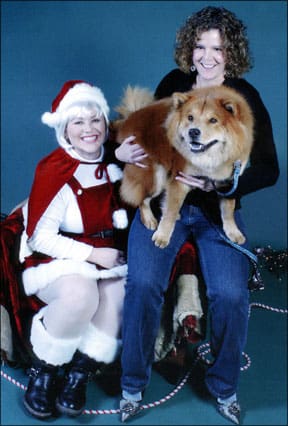
288
If training isn’t fun for the dog (if there are no pay-offs), there actually isn’t any training, except what’s called “extinction” – the decreased likelihood of the animal doing the behavior. Trainers must keep training fun for the dog.
Anyone can do it
What are some things anyone can do to keep the training fun? Audition the likely reinforcers, especially ones the owner might enjoy furnishing: roughhousing, fetch, tug, chase-me games, massage/scritchies. How neat would it be to find an activity that both participants love! Then come up with creative ways to initiate these right after nice behavior. Stuff a toy up your shirt, and quickly whip it out when your dog does a smart recall. If you come home and your dog sits rather than jumps up, say “Yippee, I’m-a-gonna-get-you!” and play chase chase chase around the house (alternate chaser-chasee, to taste).
One of the engaging things about dogs (and about all relationships) is finding out the little quirks, small things that float the other’s boat. For instance, I have a foster puppy; having him would have been generic hell-on-earth puppy rearing, but I discovered he likes scritchies right there on his chest. He grooms me when I do it, and gets a milky expression. Mutual reinforcement! He also loves it when I pant at him – makes him grin. Delightful! I can haul these cheap activities out when he demonstrates restraint and doesn’t bite my ankle at the usual time, or sits.
I also advise people to teach more tricks. Trainers need to knock it off with their lists of things “all good dogs should know . . .” What a guilt trip! Let the owner set the itinerary. What could get the dog on “Stupid Pet Tricks” on David Letterman or amaze their friends? It’s very reinforcing for owners to have people go “Wow!” at the dog’s trick or make people laugh.
Keeping Dog Training Fun and Playful
Dogs are one of the rare species of animals who play throughout their lifetimes; perhaps it’s one of the reasons we have such strong bonds with dogs, because we too play as grown ups.
Humans and canines appear to be what scientists call “neotenous”: as adults, we retain many of the behavioral traits of juveniles. In most species, play is for the young. Think about it: calves and lambs frisk about and chase each other; but how often do you see adult cows and sheep playing with one another?! Dogs and humans, though, maintain high levels of play even into adulthood.
We are also obsessed with toys, or “object play” in scientific terminology. This is very rare in animals, and I think it’s another reason why we are so bonded to dogs. (Look at how much we love balls! There is more time devoted to baseballs, footballs, tennis balls, basketballs, golf balls, and soccer balls on the evening news than there is to world peace, hunger, politics, and our local government . . . Just listing the different “object” related sports could take up a paragraph. We are truly obsessed with balls – we must be Labradors at heart!)
Of course, there are dogs who don’t exhibit an interest in balls, and I empathize with them. I was one of those kids who wasn’t very sports-minded. When I was forced to play softball in elementary school I used to stand in right field repeating “Please don’t hit the ball to me, please don’t hit the ball to me!” But overall, people (and dogs) like me are the exception and there are an awful lot of people and dogs who are crazy about balls.
So, given that play is something both people and dogs love, surely we should use it frequently as a reinforcement in training. Even though I love food, both personally (!) and for training, I think play is often underutilized as reinforcement. I have seen play be even more successful than food in some cases, and play is such fun for both species that sometimes I think it reinforces both species at the same time. That encourages people to do more training, and what a good thing that is! I’m not alone; many other trainers in search and rescue, scent detection, and bomb detection use play as a reinforcement because it is so highly motivating.
I’ve found play to be helpful in some cases with serious behavior problems, with, for example, dogs who are aggressive with other dogs. If you have a dog-aggressive dog who loves to play, one of the best reinforcements you can use for appropriate behavior around other dogs is play: tug of war or chase the ball, for example. Often, the magic of classical conditioning takes place, and ultimately the dog associates the sight of other dogs with the light-hearted emotions associated with play.
Play for Family Dog Training
However, it’s not just professional dog trainers working with serious behavior problems who should use more play in their training: Play can be a cornerstone of positive-based family dog training. Do you want to teach your dog to not run to the door and jump on a visitor? If he likes toys, teach him to go get a toy when he hears the doorbell. Encourage him to bring it out and show it to everybody. Want your dog to drop something on cue? Teach him “Take it” and “Drop it” when you play tug games.
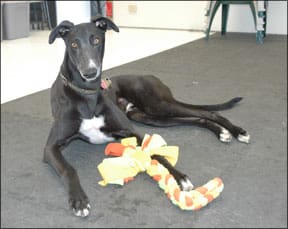
In addition, trick training is a wonderful way to incorporate a playful demeanor into your dog’s life. We all like to show off our dogs’ tricks, and we don’t seem to take it personally when dogs don’t perform up to our expectations like we do with standard “obedience” signals. Think about it: When we teach our dog tricks, we tend to have a cheerful and fun-loving attitude, but often when we’re training something like lie down, we get stern and serious. “DOWN!” we often say with a low, commanding voice, and if our dog disobeys it is tempting to take it personally.
But when we are training a dog to jump through a hoop, it’s more like, “Jump through the hoop, jump through the hoop! Yay! What a good boy! Aren’t you cute?!” Even if our dog doesn’t do it right, we say “Oh well, it’s just a trick!” Of course, we do need to train our dogs to do some things first time, every time, but it’s much more successful if we make it fun for both the teacher and the student!
It’s easy to do: Make asking a dog to sit the most fun game in the world. “Sit! Yay! GOOD DOG! Here, have a tennis ball!” Intersperse “sit” and “down” with tricks – jump through the hoop or “Aren’t you ashamed of yourself?” (This is one of my favorite tricks. You say “Aren’t you ashamed?” and your dog hides his head under a pillow!) Work on sit and then play tug. Ask for a down, and then throw a toy. You’ll end up with a dog who listens better, instead of tuning in only after the third time he hears the cue: “Sit! Sit! Sit!”
Observation is Critical
A word of warning for a potential pitfall: Don’t confuse your fun with the dog’s fun. In other words, what is enjoyable for you may not be enjoyable to the dog. All dogs are different; they enjoy different things, so you can’t assume that if it’s fun for you, or another one of your dogs, it’s equally fun for every dog.
For example, most dogs love to be petted, but not in every context and not in all ways. Most people like petting their dogs, but some don’t notice that their dogs don’t like being pat-patted on top of the head as reinforcement for coming when called.
Observe your dog carefully; if he backs away from you when you reach to pet him, pay attention! He’s telling you he doesn’t want to be petted – and that if you persist, you are actually punishing the behavior you meant to reward! I’ve seen this scenario repeated literally hundreds (thousands?) of times, when a person calls their dog away from something really tempting – say, for example, another dog who is getting food. The dog leaves a handful of liver, comes back to his owner . . . and the owner happily and enthusiastically pats the dog on the head. The person feels so good and is so happy – “Good dog!” And the dog turns his head away and hates it!
If a dog turns and walks away, that’s invaluable information: he doesn’t like what you did. Even if he just closes his mouth and/or turns his face away, pay attention. That could be your dog telling you, “Um, I really don’t like this.”
Get in the habit of carefully observing your dog’s response to your rewards, but also observe his response to training overall. Does he quickly engage with you any time you initiate a training session? Or does he dodge your gaze and wander off when he hears you call, or sees you gathering your training equipment? If he responds with the latter, you need to rethink your sessions.
Are you training too many times a day? Are your sessions too long? If your dog’s response is anything less than highly enthusiastic, do whatever it takes to make the sessions more enjoyable. If you are training a lot, try reducing your sessions in number and/or length. (In my experience, some motivated trainers tend to overdo it. Try one schedule for three days; then try another schedule for three days. See how the dog does with each.)
Novice trainers more often tend to give up too fast, sometimes before the dog has had a chance to figure out what was expected. Most importantly, ask yourself if you and your dog are having a good time, and if both of you are learning something in the process.
Just Go Play!
There’s so much to talk about on the topic of training, and using play as a part of that – I could go on and on. However, I’d much rather you finished this article, and then go out and play some more with your dog. Let the games begin!
Acquiring a New Dog or Puppy
So, we have a new dog! I’m soooo happy! And while it’s been really time-consuming to properly integrate a new dog into our household, it’s also been incredibly rewarding, interesting . . . and inspiring! Inspiring to have a fresh opportunity to experience many of the things we talk about in Whole Dog Journal – with a sense of urgency and immediacy I haven’t had for quite some time!
Just in our first few days I was thinking hard about things like potty training, how to deal with dogs who are not food-motivated, finding a good vet, vaccination, parasite control (fleas, ticks, heartworm), introducing dogs to cats, barking, leash manners, the best food, itchy skin, digging (as you’ll see on page 18), no-slip collars, dogs who are uncomfortable indoors, quiet clickers, and much more.
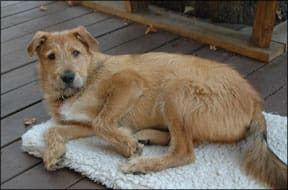
288
I’m lucky: I have all 11 years of Whole Dog Journal’s archives at my disposal, so I’ve been able to quickly look up and review an article on every single thing I’ve had questions about. Nevertheless, there is a difference between intellectually “knowing” something and really, really knowing it. I’m finding myself “learning” quite a few things that I already “knew,” if that makes any sense at all. This has been a terrific reminder that no matter how much you know, you forget some important things.
At risk of talking about our new dog too much, I thought for a few months that I could share with you some of the problems or challenges I’ve had with Otto (that’s his name), how I have solved them, and what resources I’ve used to make my decisions – including articles from our back issues. It’s my sincere hope that this will be helpful to any of you who are thinking about getting a new dog, or recently got a new dog.
First issue: Selection
This time around, I really needed to have my husband Brian “buy into” the concept of getting a dog. I already had a dog, my heart- and soulmate, Rupert, when Brian and I met 12 years ago. Brian embraced Rupie and all his Border Collie eccentricities because he had to; Rupert and I were a package deal. But Brian got kind of duped into going along with the next two dogs that spent a lot of time with us: Mokie, a long-haired Chihuahua I ended up keeping after I dog-sat him one summer; and Cooper, Brian’s dad’s dog, who stayed with us for a month while my in-laws took a cruise, and ended up living with us for months in what turned out to be hospice care. Brian tolerated each dog, but didn’t get very attached to either one. (I, of course, get attached to every one.)
After Cooper died, I promised Brian that our next dog would be a dog picked out with him in mind – a dog with as many of the traits he liked as we could find. And I would let him determine when the time was right.
Last month, right after I shipped the last issue to the printer, Brian said the magic words: “We need another dog.” Yippee! The catch: It had to be a dog he liked. And the dog had to come with a list of attributes that he wanted in a dog.
Some words about my husband: Brian is not what I’d call a dog person. He likes dogs okay (and dogs always seem to like him), but he admits he’s not the kind of guy who is ever going to hug or kiss a dog – so a clingy, needy dog or a lap dog is never going to be fully embraced. He likes dogs when they are attentive but not pushy; quiet but alert; ready to take your leftovers but not begging for them; interested in going for walks but not difficult to walk . . . In other words, he likes grown-up, self-contained, well-trained, outdoor kinds of dogs. Preferably medium-sized and non-shedding!
Oh, and Brian was also hoping we could find a dog who would chase stray cats (and the occasional skunk) off our property – but one who would never chase our older cat.
In April 1999, we published an article by Whole Dog Journal’s Training Editor Pat Miller on things to keep in mind when looking for a new dog at your local shelter (hmm; it looks like we’re overdue to publish an updated version!). “Second-Hand Friends” advised prospective adopters to develop a list of traits that they “must have,” “would like to have,” and “won’t have.” “When you go to visit adoption prospects,” Miller wrote, “take your list with you, and make sure you don’t compromise anything that the family has agreed is a ‘must have’ or a ‘won’t have.’”
The night Brian gave me the go-ahead, I jumped right on to the Internet to look at the dogs currently available for adoption at our local shelter, the Northwest SPCA in Oroville, California. I was looking for medium-sized adult dogs who looked like they might be friendly, uncomplicated, mellow, and not clingy. About four or five dogs caught my eye, but my favorite was a big terrier-mix, about seven or eight months old. I can’t say why.
The next day I was down at the shelter. I took a half-dozen dogs out for long walks, but my absolute favorite was still the terrier. He seemed very friendly, but not frantic to jump up or get in my lap. Every time he offered a sit, I doled out a treat – and he turned into a sitting machine within a minute. He’d sit, and if I didn’t deliver a treat fast enough, he’d quickly stand and then sit again, harder. Smart! I liked that. As motivated as he seemed to be for the treats, however, he took them gently and calmly from my hand, and I liked that, too.
There was just one red flag: The dog’s cage card indicated that he had a rap sheet: “Kills chickens,” it said. That could mean he was predatory – or it could mean he was just an ordinary young dog on the loose with time on his paws and a chicken coop in his neighborhood. With the permission of the shelter staffers, I took the dog on leash into a room full of caged cats, to see if he turned into a hunting, chasing machine. He was interested, but his tail wagged furiously, and he readily turned away from the cats, back toward me, when I patted my leg and offered him a treat.
I called Brian from the shelter. “Would you come down and meet the final candidates?” I asked. “Tell me about the dogs you’re considering,” he countered. After he listened to me tell him about the dogs I was considering – but mostly about the terrier – he laughed. “It seems like the terrier has everything on your list that we wanted, as far as we can tell. Why don’t you bring him home and we can give him a shot?” he asked. I’m pretty sure he knew full well that any dog that left the shelter with me was going to live with us for the rest of the dog’s life!
Bringing him home
I was filled with excitement as I filled out the adoption forms at the shelter. I practically danced out the front door with the dog’s leash in hand – and the dog was dancing, too. “Yay! Out of the shelter! . . . But wait! You want me to get in that CAR?!” When I opened the car door, the dog suddenly looked aghast and dug his heels into the ground; he also quickly ducked his head in the manner of a dog who is very experienced at slipping his collar. Oops! I slacked the leash, to prevent him from slipping free, and we retreated back into the shelter to tighten his collar. Lesson one: Assume nothing about your new dog! And make sure his collar fits!
On our second attempt, I had a shelter staffer help me with the doors, and this time, I simply picked the dog up, carried him to the car, and put him on the back seat. He immediately slithered onto the floor, looking like a deflated balloon. I’m glad that “must love riding with me in the car” was not on my list of selection criteria!
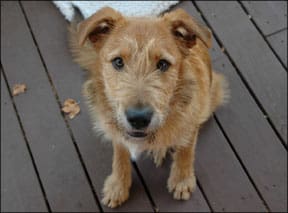
288
Fortunately, he instantly regained his buoyancy the moment I opened the car door and grabbed for his leash. He bounced out of the car and through the gate into our fenced yard as if he had lived there forever; he was practically whistling (and I know I was grinning). We went up on the front porch, I opened the front door, and oops! He hit the brakes again. “I’m not going in there!” Hmm! Okay, let’s go around to the backyard, then!
I brought the dog around the side of the house into the back and Brian came out to look. “He’s sort of cute,” he waffled. “He doesn’t want to go in the house,” I said.
“That’s my dog!” Brian exclaimed.
Don’t worry, he goes in the house now. Although, to Brian’s delight, he does seem a lot happier sleeping outside than indoors.
Home to stay
A lot has happened since that first night, and I’ll catch you up in upcoming issues. For now, suffice to say that within a day, despite some little hitches and adjustments, both Brian and I were certain that we really liked the dog, and he was going to fit well into our family. On day two, we were already discussing what to name the dog.
I didn’t take my husband’s last name (Maddock) when we married; we both had children from previous relationships who share our own last names and we didn’t want to confuse matters. But Brian had a list of names he had always kidded about wanting to name his children – although his first wife wouldn’t agree (thank goodness). He always wanted a girl named Prag Maddock, he joked, or perhaps Dram Maddock. And he always wanted a boy named Otto Maddock. I knew when Brian said, “How about we name him Otto?” that the dog was home for good.
Dog Vaccination Information
Dog vaccinations are something that every dog owner should be educated about, and yet few seem to think about them at all, except to wonder about the need for them after they get a new dog. However, many people base this concern on the vet bill, rather than worries about the potential for side effects in their dogs!
Immunology expert Ronald Schultz, PhD, Diplomate ACVIM (American College of Veterinary Internal Medicine), has spent much of his career studying animal vaccines. Dr. Schultz is professor and chair of the Department of Pathobiological Sciences at the University of Wisconsin-Madison School of Veterinary Medicine, and has more than 40 years’ experience in the field of immunology. His long-time university employment – as opposed to a career in industry – has provided him with a unique position of neutrality from which to observe the dog vaccination industry.
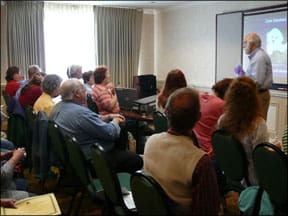
Dr. Schultz is on the American Animal Hospital Association (AAHA) Canine Vaccine Task Force and the American Association of Feline Practitioners (AAFP) Feline Vaccine Task Force; these two organizations provide guidelines to the veterinary industry for canine and feline vaccination programs. Recently, Dr. Schultz was also asked to help develop the canine and feline vaccination guidelines for the World Small Animal Veterinary Medical Association.
Known for his research on the duration of immunity (DOI) of common canine vaccinations through serological (antibody titers) and challenge studies as far back as the 1970s, Dr. Schultz co-published a paper in 1978 in which triennial vaccination was recommended over then-standard annual vaccination. It took 25 years, but in 2003, the American Animal Hospital Association (and the American Veterinary Medical Association) at last supported his thesis that canine “core” vaccines need not be given more often than every three years.
Dr. Ron Schultz was also one of the few canine vaccine experts to point out that the yearly recommendation included on vaccine labels was not based on any scientific studies nor ever scientifically validated!
Most vaccine makers today perform duration of immunity studies in order to ensure the minimum duration of immunity for their products; they have to be able to guarantee that their products convey immunity in most animals for a minimum period. But they lack any sort of incentive to run DOI studies to determine the maximum period of immunity conveyed by their products; indeed, if the products work longer, people will need less of them.
Long studies are astronomically expensive. According to Dr. Schultz, the cost of running a three- to five-year DOI trial involving 20 animals is roughly a half million dollars.
Since the industry won’t do it, dog owners will. Among many other research projects, Dr. Schultz’ current work includes partnering with W. Jean Dodds, DVM, on the privately funded Rabies Challenge Study. This study is testing the hypothesis that current rabies vaccines offer protection of at least five to seven years, if not longer. The study is overseen by a 501(c)(3) non-profit, the Rabies Challenge Fund Charitable Trust, which accepts donations to cover the costs of this important project. (For more information on this worthy project, see the Rabies Challenge Fund.)
Dog Vaccine Basics
Unlike some busy professors and research scientists, Dr. Schultz also frequently makes himself available to the communities who are most interested in his work – in this case, dog and cat enthusiasts.
Earlier this year, I had the honor of arranging for Dr. Schultz to make a presentation to a club I am involved with, the American Bouvier Rescue League in Alpharetta, Georgia. In his talk, Dr. Schultz discussed the pros and cons of types of vaccines (i.e., modified live vaccines [MLV], killed, etc.), the immune response to vaccines, vaccine protocols (core and non-core), risk/benefit assessments, titers, and adverse reactions.
The following are topics Dr. Schultz covered in his talk. I summarized points in his presentation; Dr. Schultz generously offered to proofread my summation for accuracy.
Duration of immunity
Duration of immunity is the length of time an animal is protected from a disease.
Antibody titers
A titer is a measurement of antibody to a specific virus (or other antigen). The antibody is in the liquid portion of blood. With parvo, distemper, and adenovirus titers, the presence of any measurable antibody shows protection in vaccinated dogs older than 16 weeks of age. The positive antibody test result is fairly straightforward; it shows you don’t have to revaccinate for these viruses. A negative antibody test result shows you need to vaccinate or revaccinate.
Using vaccine antibody testing as a means to assess vaccine-induced protection is likely to result in preventing the animal from receiving needless and unwise booster vaccinations.
Serological study, challenge study
A serological study measures the animal’s antibody levels (titer) against a specific virus or agent. In very simple terms, a challenge study is one in which animals are injected or “challenged” with the infectious agent, post-vaccination, and observed for signs of disease.
“Core” vaccines for dogs
Dr. Schultz considers the following vaccines to be the “core” (or basic) vaccines that every dog should receive: canine distemper (CDV), canine parvovirus 2 (CPV-2), canine adenovirus 2 (CAV), and rabies. Core vaccines protect animals from severe, life-threatening diseases that have global distribution.
Puppies should not be vaccinated before five weeks of age because their immune systems are immature, and the presence of maternal antibodies can block the puppy’s immune system from responding appropriately. Ideally, in a nonshelter situation, the first puppy shots (CDV, CPV, CAV) should be given at eight to nine weeks of age. The rest of the series should be administered with a minimum of two weeks between doses, but preferably three to four weeks, to give the immune system time to properly respond. Thus, ideally, the next shots would be at 11 to 12 weeks, followed by the last at 14 to 16 weeks.

A series is necessary because we do not know at what point the maternal antibodies are low enough not to block the puppy’s immune response. Research shows that less than 50 percent of puppies will respond at six weeks; 75 percent at nine weeks; 90 percent at 12 weeks; and by 14 to16 weeks, close to 100 percent will respond. However, a titer can be checked two or more weeks after the last shot in the series to see whether the puppy’s immune system responded in the desired fashion.
After that, recommendations are to “boost” one year later, then vaccinate healthy dogs not more often than every three years thereafter, or better yet, run antibody titers. This, again, is a conservative approach from a veterinary standpoint as Dr. Schultz and other researchers have data showing that after the initial round of vaccines, most dogs will have immunity for life from CDV, CPV, and CAV.
Rabies
The rabies vaccine is the only vaccine mandated by law in most states. The first rabies vaccine should be given no earlier than 12 to 16 weeks of age, or as local law dictates, then again one year later. The three-year vaccine, if accepted by state law, can be administered at that time, and then every three years thereafter. The rabies vaccine should be administered by itself at a later date, in a different area on the dog’s body, from the other three core vaccines. Some states offer exemption policies from the rabies vaccine for dogs who have medical conditions that contraindicate vaccination.
The rabies vaccine is the most reactive virus vaccine, and it is the only core vaccine that requires a minimum DOI study to be approved by the USDA.
Despite a French study that has shown (by challenge) a DOI of five years, and serological studies have shown a DOI of at least seven years, currently, the USDA has approved only studies of just three years’ duration for the rabies vaccine. This is why the Rabies Challenge Fund Study, which will follow the strictly defined federal APHIS/USDA standards for licensing rabies vaccines in concurrent five- and seven-year challenge trials, is so critically important to our dogs’ health.
Annual vaccination
The adage that “if it doesn’t help, it won’t hurt” is not true for vaccines. If a dog were vaccinated (and did not require it), the dog would not respond with a significant increase in antibody titer, but might develop a hypersensitivity to vaccine components (e.g., fetal bovine serum). Furthermore, the dog should not be revaccinated since the vaccine could cause an adverse reaction (hypersensitivity disorder).
In a 1992 paper Dr. Schultz wrote, “Extending the revaccination intervals for canine core vaccines does not place the animal at increased risk to developing vaccine preventable disease, but it does reduce the potential for adverse reactions.” Even the three-year protocol is very conservative, as studies point to the core vaccines having a minimum DOI of seven years or more. This is why running a titer, versus vaccinating even only every three years, is preferable.
Dogs with unknown vaccination histories (rescue or shelter dogs)
For a rescue dog with an unknown vaccine history, the first choice would be to run antibody titers, particularly if it is an older dog. Otherwise, with a healthy dog, Dr. Schultz would recommend vaccinating for parvo, distemper, adenovirus, and rabies. A conservative approach is to give two doses of CPV, CDV, and CAV, three to four weeks apart. However, one dose is considered protective and acceptable in a dog over sixteen weeks of age, according to Schultz’ research.
The rabies vaccine would be administered per state law (typically an initial dose, followed by another one year later, then on a three-year schedule). A dog coming in with a known vaccine history should not immediately be re-vaccinated; use the three-year time frame from the date of the last vaccine, or better yet, run a titer, especially if there is doubt about the validity of the shot records.
Don’t “do it all at once”
In the short-term interest of time and money, dogs are often vaccinated while at the vet clinic for spay/neuter surgery. However, it is best not to do this; the dog may develop a hypersensitivity reaction and vomit, leading to an increased risk of aspiration. Also, anesthetic agents may be immunomodulatory. Whenever possible, vaccinate prior to a surgical visit.
“Non-core” vaccinations
Non-core vaccinations include para-influenza, Bordetella bronchiseptica (kennel cough), Borrelia burgdorferi (Lyme), and leptospirosis. These vaccines should be administered only to dogs whose geographical location, local environment, or lifestyle places them at risk of contracting each of the specific infections.
Interestingly, as opposed to the viral vaccines, immunity from bordetella and lepto vaccines often lasts less than one year because they are bacterial diseases. And neither actually prevents the disease, but rather manages the disease and its severity. Lepto vaccines are the most reactogenic of all the vaccines, even more so than the rabies vaccines.

Coronavirus (CCV) and giardia vaccines are not recommended, as the 2006 AAHA Guidelines note, “Prevalence of clinical cases of confirmed CCV disease does not justify vaccination.”
If vaccinating a puppy with non-core vaccines, in general, with the exception of intranasal bordetella, which can be given with the core vaccines, the viral vaccinations should be given first, and the bacterials should not be mixed.
Need for vaccination
A study of shelter dogs revealed that only 50 percent were vaccinated. To achieve “herd (population) immunity” and prevent epidemic outbreaks, at least 75 percent of the population should be vaccinated. Clearly these diseases still exist in our society, but our desires to protect our dogs both from disease and the dangers of overvaccination do not have to be mutually exclusive. A well thought-out vaccination protocol for our dogs can help us to protect them from disease, yet at the same time, reduce the risk of adverse reactions.
Dr. Schultz notes that if the public could be educated to have pets older than 16 weeks of age vaccinated even once with the core vaccines, this would help immensely with herd immunity. With rabies, one vaccine is better than none in offering protection, but a minimum of two is considered better yet. The CDC notes that “no documented vaccine failures occurred among dogs or cats that had received two [rabies] vaccinations.”
Individual Immunization Decisions
The most important message from Dr. Schultz’ talk is that there is no one vaccine program; vaccine programs must be tailored to the specific needs of each animal. Although there is a tendency to want to treat all dogs the same, the program should be designed for the individual, not the masses. Often, the burden falls on the shoulders of the dog’s guardian to ensure that the pet receives the optimal program that takes into account his age, health, environment, and lifestyle.
Solutions for a Dog Who Digs the Yard
[Updated August 9, 2017]
DIRT-DIGGING DOGS OVERVIEW
– If your dog likes to dig and you have a yard with a bit of room, build a sandbox for him!
– Keep the sand damp; it makes it more inviting to dig in.
– Bury some of his toys in the box, and encourage his digging there.
– Cover the box at night if there are cats around; you don’t want it used as a litterbox.
The perfect storm, canine edition: Combine one dog who is accustomed to and prefers spending time outdoors; a spate of hot, dry weather; a lush, productive garden full of herbs and tomato plants growing in raised boxes full of expensive, loamy soil and moistened three times daily by an automatic drip system. What do you get? Holes dug in the garden and an irate husband!
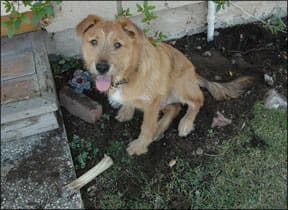
Our new dog, Otto, nearly made himself quite unwelcome on his second day in our home. Every time I turned around, I’d find him digging in any place we’d recently watered, including the lawn, a flowerbed in front of the house, underneath a gorgeous hydrangea bush that’s already hard-pressed to survive our hot summers, and, most seriously, the vegetable beds in back. “Can’t you train this dog not to dig?” my husband implored.
But this wasn’t a training issue; I’ve been trained enough by Pat Miller and our other contributing trainer/writers to recognize a management situation when I see it!
Dog Training vs. Dog Management
Training is the right thing to do when you want to get a dog to do something specific: fetch a ball, sit when greeting people, walk calmly on leash. But when you would like a dog to not do something – especially when you’d like him to not do it in your absence – you need to manage the situation.
For example, if a dog gets into and eats stuff out of the kitchen garbage pail, you could try to “catch him in the act” and punish him for it, or set up booby traps that would accomplish the same thing. Unfortunately, dogs generally have more idle time on their hands than we do; these approaches take more time and surveillance skills than most of us possess. Traps and stakeouts are unlikely to be successful, anyway; with a random reinforcement of some tasty old food, most dogs are motivated to persist through whatever traps or punishment they occasionally are subjected to. It makes far more sense to manage the situation by putting the pail in a location where he can’t possibly get into it (under the sink, say, with a baby-proof latch on the cupboard door).
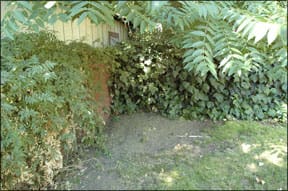
Make a Compromise with Your Dog
Management solutions are most successful if they both A) absolutely prevent the dog from being rewarded for doing the thing you don’t want him to do, and B) reward him for doing something else. Unless we keep Otto inside (which he really doesn’t enjoy, and seems to encourage him to chew on household items), build a kennel on a concrete slab, or cover our entire lot in concrete, we can’t prevent Otto from digging. Fortunately, we have room in our yard to try Plan B: to give him a rewarding experience doing what he wants to do, but in a location of our choice.

It was clear to me that Otto wasn’t just digging for the fun of digging; he wasn’t burying toys or looking for gophers. Rather, he was trying to find a cool, damp place to beat the hot, dry weather we have all summer long in this part of California. Once he got a hole dug, he’d circle and hunker down in the hole for a nap. I proposed that we provide Otto with an especially cool, damp, shady spot where he could dig and snooze to his heart’s delight.
Doggie Sandbox Methods and Materials
Otto is a good-sized dog, about 50 pounds and fairly long. We wanted the box to be big enough for his digging and relaxing pleasure. After measuring his stretched-out length, we decided the ideal size would be 4 feet by 6 feet, and so we bought two 10-foot boards from which to make the frame. We also decided that 10 inches would be deep enough (he really didn’t dig very deep, just wide, when he dug), so we used boards that were 2 inches by 10 inches, in a low-cost ($8.50 each) variety of fir. We could have spent more for prettier (and rot-resistant) redwood, or used long-lasting pressure-treated wood, but since we didn’t know for sure if this solution would work, I felt the low-cost way was the best way.
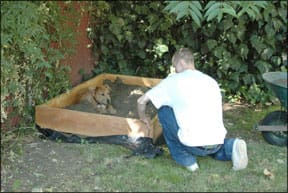
My stepson Clark cut the lumber into 4-foot and 6-foot pieces, and screwed the ends together (as shown below) and I took our truck to buy some sand. I had phoned ahead to make sure that the landscape supply center had clean “sandbox” quality sand; not construction-grade stuff for mixing into concrete. One-half of a cubic yard filled our box perfectly, cost $20, and was well within the safe carrying capabilities of our little Ford Ranger pickup.
Doggie Sandbox Success!
The box was a smash hit with Otto before it was even completed. I had barely begun filling the box with sand when Otto got in, and he didn’t get out until hours later. Best of all, a month later, it’s still his favorite place to spend a hot day – and he’s dug another hole in the garden only once. He stays relatively clean (compared to when he was sleeping in damp soil), and though he has thrown a lot of sand out of the box, its out-of-the-way location means it’s fine by us.
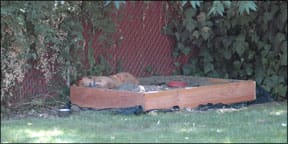
If he hadn’t taken to his sandbox so quickly, I was prepared to spend time with Otto in the box, give him treats and praise for hanging out there, and perhaps show him how to bury and dig for some of his favorite toys. None of these were necessary – but building sand castles, just for the fun of watching Otto happily dig them apart, has proven to be a blast.
Download the Full July 2008 Issue PDF
Join Whole Dog Journal
Already a member?
Click Here to Sign In | Forgot your password? | Activate Web AccessPay Attention!
Few people pay attention to their dogs when walking with them, I’ve noticed. I’ve observed this on many occasions, but the point was brought home rather forcefully for me recently.
Just the other day, I spent the better part of a warm, late afternoon in an upscale Bay Area neighborhood, in an effort to take some pictures of the many dog owners I knew would be out walking with their dogs. I was hoping to take a good picture of a relaxed person and a well-behaved dog, walking calmly on a loose leash and a plain collar. I wanted the picture to illustrate the article that appears on page 8 of this issue.

288
I saw dozens of dogs and dog walkers – but not a single pair who met the criteria for the photo I wanted (I used an older photo for the article). Mostly, I passed dogs who were pulling their owners this way and that. And many of them were wearing choke chains or pinch collars. Have you ever noticed that most dogs who wear these collars pull anyway? (If you want to know why, read Training Editor Pat Miller’s article inside this issue)
I also saw several dogs wearing harsh collars (and one wearing a head collar) with a retractable leash! Folks, a retractable leash literally trains dogs to pull against the mild pressure of the spring-loaded cord, so they can reach whatever they are pulling toward – which is highly reinforcing.
But here is the thing I find most puzzling: with a single exception, none of the dog walkers appeared to be paying a bit of attention to their dogs. I saw only one woman who noticed when her dog happened to be walking at her side, and took the opportunity to praise him and give him a treat. With this sole exception, no walkers seemed to notice when their dogs were being good – and none appeared to notice when their dogs were pulling them toward a bush or piece of garbage on the sidewalk. Never mind that their arms were being pulled practically out of their sockets, or that they had to brace themselves against being pulled off their feet (or pulled to a halt when their dogs stopped to sniff or pee); these owners just sort of passively, ineffectually resisted their dogs’ movements.
What were they paying attention to? Their walking partners, stroller-bound babies, cell phones, iPods, and goodness knows what else. But with the sole exception of one attentive owner, they were neither paying attention to nor taking the opportunity to train their dogs to walk on a loose leash.
Many people today are multitasking: combining the dog-walking chores with exercising for personal fitness, returning phone calls, and spending some much-needed time with a friend or child. But if they want a well-behaved dog as much as I would like them to have one, they need to focus on their dogs! When your dog pulls toward something, don’t let him reach it (and thereby be reinforced); stop in your tracks and resist until he slacks the leash. Carry treats, watch for even fleeting moments of good behavior – and reinforce it the moment it occurs. Before you know it, walking your dog will be much more fun – and photogenic!
-Nancy Kerns



